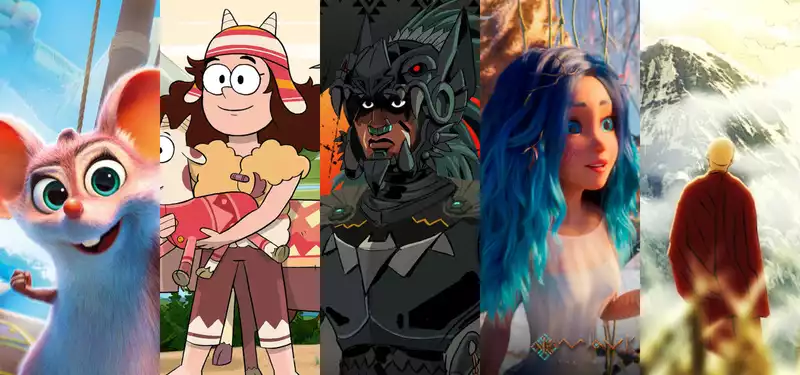Jun 19, 2023
Independent Animation Producers Share Tips for Surviving and Thriving in an Increasingly Global Animation Industry
With popular IP productions dominating the box office and TV ratings, surviving as an independent studio has never been more difficult.
There are no guidelines for survival in this industry, and in most cases no government policies to turn to when serial projects fail to find an audience. Becoming an indie studio means either establishing a niche and hoping the market will get there, or studying market trends and pursuing popular storytelling styles.
With no single recipe for success for indie studios, it was significant that the Annecy Film Festival brought together five representatives of world-class indie studios to discuss techniques for survival. Jose Carlos Garcia de Letona of Ánima Estudios in Mexico, Carlo Stella of Mad Entertainment in Italy, Lindsey Adams of Daily Madness Productions in Ireland, Tat Productions' Jean-Françoise Tosti, and Ukraine's Film.ua's Iryna Kostyuk shared their insights.
Each studio had a different approach to the contemporary marketplace and shared a number of blueprints for aspiring studios to emulate or combine. First, Tosti said of TAT, "We are looking for a family audience, not just kids. We are looking for the whole family." This distinction is essential, and too often the two audiences are confused. Family films and children's entertainment can have very different shades, and TAT aims to be a staple of family films.
Rather than licensing IP, TAT develops its own ideas and develops films completely independently. Tosti explains, "We invest a lot of our own money in the beginning [of a project], when we don't even know if it will pay off." Tosti explains. This approach requires flexibility; TAT is constantly changing, assessing the likelihood of project success and leaving room to expand or roll back projects based on its projections. and researching where the market is going, rather than copying what is popular at the time, TAT has established a high-risk strategy.
At Daily Madness Productions, the main focus is on television production, with the hope of eventually moving into feature films. In order to expand more generally and improve the quality of its product, the studio needs to acquire talent. The method employed by Daily Madness requires a close ear to the ground. We love animation," Adams says, "but we don't necessarily love the infrastructure of the industry. We're trying to pick up talent left out of other studios and amplify underrepresented voices."
Much of Daily Madness' work is service-oriented, helping other studios realize their visions while providing additional funding for their own projects.
Mexico's Ánima takes a different approach to attracting audiences than traditional feature films and television shows. Starting out by producing content for youth, Ánima has shifted its focus to children's television and has launched various Youtube channels for distribution. With about 40 million channel subscribers, the endeavor has been a success.
"For those who watch the show on air, there is additional content on Youtube; for those who find the show on Youtube, there is additional content on air," de Letona explains. Original IP can be developed for two audiences at the same time, strengthening the brand. In this day and age, targeting children with short-form content automatically means that Youtube must be part of the distribution plan.
However, original IP is not all that Anima is about. Anima is working on "Batman Azteca" and has licensed "Batman Azteca" and adapted "Batman Azteca" for the local market. Licensing provides an alternative route for independent studios to gain popularity, but such licenses are difficult to obtain because many rights holders are overprotective of their property or choose to allow larger studios to interpret their characters.
For Ánima, larger productions are achieved through co-productions with other, often foreign, studios. De Letona says of co-productions, "They are very valuable in creating unique projects. The larger the budget, the more you can push visuals and storytelling further, resulting in a more expansive studio portfolio.
As Irina Kostyuk of the UA Group discovered, co-production is not always the smartest way to go. The studio's latest film, "Mavka. Song of the Forest," the highest grossing Ukrainian film ever, was almost entirely a co-production.
"After a year of negotiations, we had five offers," Kostyuk explained. 'When you co-produce, you have to do some kind of production in the country. When we calculated the costs, co-production was actually more expensive. Balancing the size of the project with the company's financial future is a constant battle for independent studios. Kostyuk and UA bet on themselves to weather the pandemic and the Russian invasion and create something revolutionary for the Ukrainian box office.
Regional specificity is another characteristic of the studios that sometimes appears in their work. For Carlos Stella of Mad Entertainment, telling regional stories is something close to home, and he sees film as an opportunity to use it to convey the unique Italian lifestyle. All the stories we want to tell come from our territory," is Stella's mission statement at Mad Entertainment. He cited Studio Ghibli's storytelling methods and how they apply universal principles to very specific Japanese locations and characters. Stella seeks to follow in the footsteps of Ghibli's "spread of Japanese culture throughout the world" and apply that philosophy to Italian culture.
Telling a localized story automatically means going against the mainstream idea that every element of a film appeals to every audience. Stella embraced this idea of rejecting four-quadrant storytelling, saying, "Independence is a great opportunity for the market to get radical."
Independent animation is necessary for the market to become interesting. Those that exist outside the sphere of big-budget crowd-pleasers can add diversity and take risks. In today's industry, however, risk can only be built on the strongest of foundations. There is no set path, but embracing and serving the local, providing a home for underrepresented talent, and betting on the story you want to tell is a good place to start.
.



Post your comment